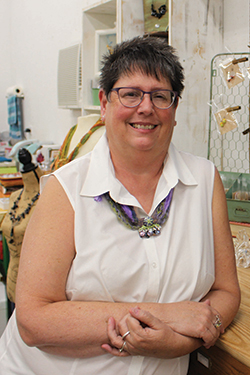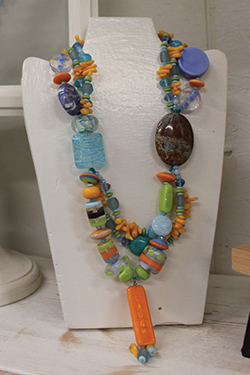A twist of fate brings Twisted Chicken Beads home to Brimfield.
She’s a glass artist who happens to make jewelry—an important distinction to make, she points out with a chuckle. “I quit saying that I make jewelry, because everyone always says, ‘Oh, I make jewelry, too!’”
Leslie P. Schenkel is a lampworking glass artist, which means she uses a torch to melt glass. Once melted, the glass can be molded into a variety of shapes. While her glass beads are eventually incorporated into jewelry, each individual bead is a miniature work of art.
Methods of Bead Making
Schenkel, who also works full-time at the Illinois CancerCare Foundation, first began making beads after taking a class in 2003. “My friend Nancy Davis called me and said, ‘You know all of those expensive beads we were looking at on eBay? There’s a class down at the Peoria Art Guild—we could make them and it would be cheaper!’” Schenkel smiles. “I got hooked.”
She soon discovered two things. It was still expensive, and while she initially took the class in order to create jewelry from the beads, she actually enjoyed the process of making the beads more than stringing them. “The process of sitting and melting glass is way more interesting to me,” she explains. “I would rather sit here and melt, than figure out what to do with them after I make them.”
Schenkel decided to turn this love into a part-time business… but she needed a name. “I had chickens at the time,” she laughs, attempting to recall the exact number. “And there was a bead store in Springfield called ‘The Beaded Pig,’ so I couldn’t be ‘The Beaded Chicken.’ At the time, I was making twisties, where I would take two rods of glass, twisting and pulling the colors out, and so I named [the business] ‘Twisted Chicken Beads.’”
Another friend, local artist Doug Goessman, created the original logo. “He asked me if it was ‘twisted’ like demented, or like dizzy and confused,” she recalls. “I said we should go with a dizzy and confused chicken—I’m not sure what a demented one would look like!”
She quickly began learning new skills, taking advanced courses in bead making and expanding her tools and equipment. Like many lampworking artists, she first used a torch with pre-mixed propane and oxygen. Today, she uses a surface-mix torch, which melts the soft glass with more efficiency. “I can now do bigger and faster work,” Schenkel adds.
The glass she uses has a coefficient of expansion (COE) of 104, which simply means that it expands and contracts at a set rate: 104 ten millionths of an inch per degree change in temperature. In contrast, Pyrex has a COE of around 32, which is why it is a fairly sturdy, hard glass. Between the two are varieties used for fused glass, with COEs of 90 or 96. Softer glass, like what Schenkel uses, is easier to work with when creating small, intricate beads.
She forms the beads on mandrels coated with bead release, which keeps the glass from sticking to the metal rod. After the bead is formed, it is cooled in a kiln—a process known as annealing. “They stay at a constant 960 degrees until I’m done for the day. The kiln is slowly cooled to reduce the stress in the glass between the outside of the bead [cools first/faster] and the inside [last/slower].” When the bead has cooled, it’s taken off of the mandrel and cleaned.
Although she makes intricate jewelry with her beads, Schenkel is clearly happiest when making the individual beads. When people notice the beads on her earrings don’t always match exactly, she tells them they are right. “I want all of my pieces to scream ‘Look at ME!’” she exclaims. “That is why most of my work is done in bright, cheerful colors.”
 At Home in the Barn
At Home in the Barn
In March of 2016, disaster struck when a tornado tore off the roof of Leslie and her husband Nathan’s home in Brimfield. Although most of the items inside the house did not leave the structure, they were covered in layers of insulation, beyond repair. The entire home had to be demolished. At the time, her studio and equipment were located in Peoria at the Studios on Sheridan.
“We had to rebuild,” Schenkel explains. “So, I had to move the Twisted Chicken home.” Her new studio, inside a newly-built barn adjacent to their new home, allows her plenty of room to continue her lampworking. Her friends often join her, some creating jewelry with her beads, and she even teaches occasional classes.
This September, her work will be featured in the Peoria Art Guild’s Fine Art Fair, which has her busy in anticipation. As she works to display her creations, she says she is moving more towards the use of fabric, avoiding metals. “I hear customers say they are allergic to metal, so I started using fiber,” Schenkel explains. “And then my sister said she was allergic to wool, so I’m trying some that just have silk, without the yarn in them, so that everybody can have something.”
The colorful fabric, paired with her glass, mixes a range of hues and textures to form what often resemble miniature sculptures. Friends will help her group certain colors and textures together, she adds, but the final selection often comes down to a gut feeling. “I don’t have an art degree,” she comments. “I can’t always say why I like this or I like that—I just know it’s what I’m going to do.” a&s
Schenkel says customers are welcome to visit her studio and can contact her through the Twisted Chicken Beads page on Facebook. Check her work out at the 55th annual Fine Art Fair, September 23-24, 2017.


